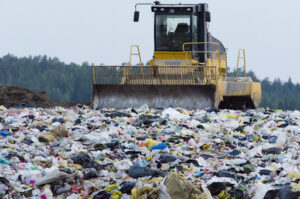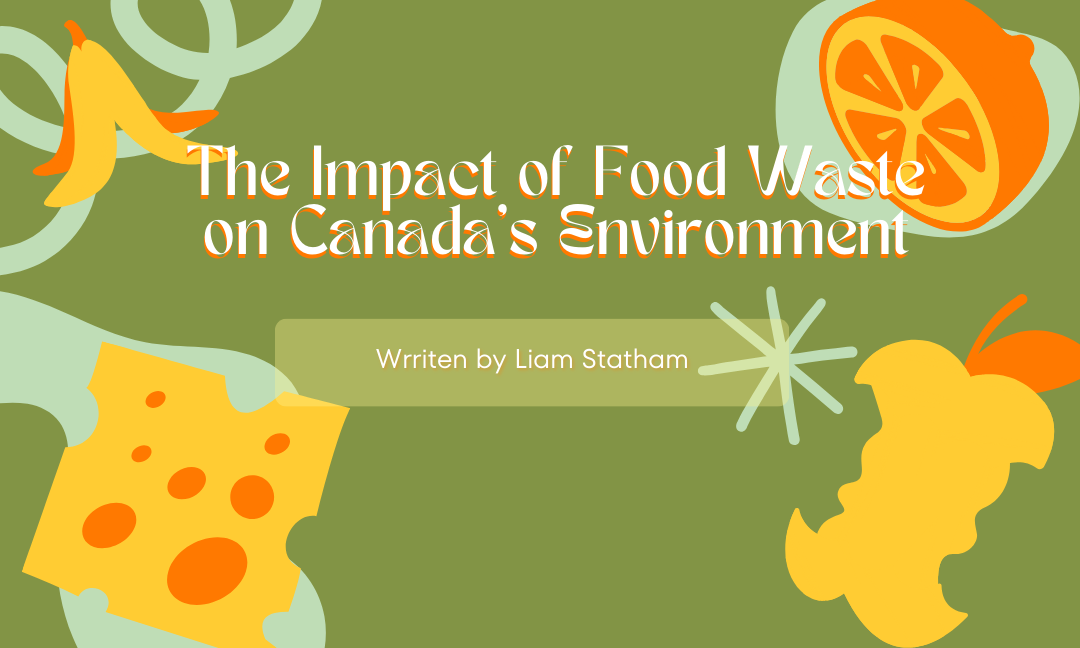Written by Liam Statham
Edited by Kiritika Rana
Designed by Kiritika Rana
Published by Kiritika Rana

According to a recent study done by the CBC, the average Canadian wastes over 170 kilograms of food every year. This creates 56 million tonnes of carbon-equivalent emissions as the food waste slowly rots away in a landfill. Food waste poses a significant environmental threat to Canada, primarily due to two issues: The resources used in its production are all squandered and after it is brought to a landfill it generates significant greenhouse gas emissions.
How Food Waste Affects Our Resources
When we waste food, we waste all the resources required to produce and transport that food. These resources include water, land, and oil. These are essential and limited resources, so we must use them responsibly.
Growing food that goes to waste accounts for using 21% of our freshwater. This is because it takes an outstanding amount of water to produce the fruit, vegetables, and especially meat that we consume. For example, it takes 50,000 litres of water to produce one kilogram of beef! This means that throwing away one burger wastes the same amount of water as taking a 90-minute shower!
 Large amounts of farmland are also required to produce food. Approximately 18% of our cropland is used to produce food that will be wasted. Additionally, as meat continues to grow in demand, more and more arable land (land that can grow crops) is being converted into pastures for animals. This leads to the degradation of that land.
Large amounts of farmland are also required to produce food. Approximately 18% of our cropland is used to produce food that will be wasted. Additionally, as meat continues to grow in demand, more and more arable land (land that can grow crops) is being converted into pastures for animals. This leads to the degradation of that land.
Finally, lots of oil is used in the transportation of food waste. Food is usually trucked long distances out of the farm it was grown in, and possibly even flown into a different country, just for much of it to be thrown out. This, along with the oil used to transport the food waste to a landfill, results in large amounts of oil being wasted.
How Food Waste Contributes to Climate Change

Approximately 58% of the food we produce ends up in a landfill. Landfills are far from the ideal place for food to decompose, as we don’t have control over the temperature, oxygen levels, or moisture levels, three key factors in the decomposition of food. Because of this, food takes much longer to decompose in a landfill than it would naturally. For example, one head of lettuce can take 25 years to fully decompose in a landfill. During this extended decomposition process, the food waste expels large amounts of methane – a greenhouse gas 25x more powerful than carbon dioxide. This methane lingers in the atmosphere for 12 years, trapping heat from the sun. Methane emissions from food waste make up 20% of the global greenhouse gas emissions released.
With much of the food waste in Canada coming from the consumer level, we must start being more sustainable with our food. Educating yourself on different strategies to help reduce your food waste is a great way to start. Here is a blog post that shares some tips on how to make your kitchen more sustainable. By taking action now, and being careful of what we waste, we can create a more sustainable future.
Resources
Works Cited
Brown, Heather. “Food Waste in Canada: An in Depth Review.” Waste Solutions, 3 Mar. 2023,
waste.solutions/blog/food-waste-in-canada-an-in-depth-review/
Lewis, Jangira. “How Does Food Waste Affect the Environment?” Earth.Org, 17 Oct. 2022,
“Food Waste.” Clean Up Australia,
Moskowitz, Dylan. “The Impact of Food Waste on the Environment.” Nature Canada, 14 Dec. 2018,
Images
Federico Respini on Unsplash

